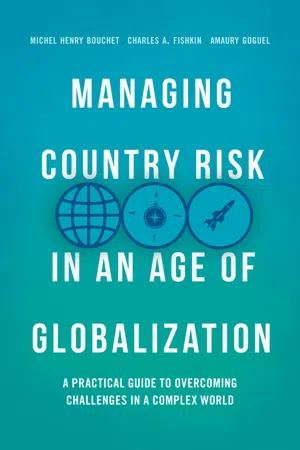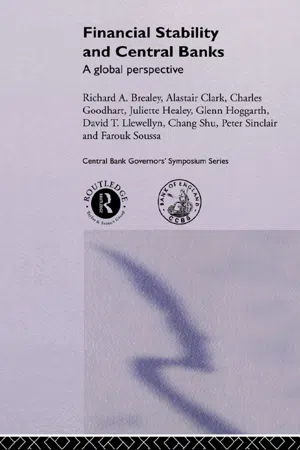Economics
Capital Flight
Capital flight refers to the large-scale exit of financial assets and capital from a country due to economic or political instability. This can lead to a decrease in investment and economic growth within the country experiencing the flight. It often occurs when investors lose confidence in the domestic economy and seek more stable and profitable opportunities abroad.
Written by Perlego with AI-assistance
Related key terms
2 Key excerpts on "Capital Flight"
- eBook - ePub
Managing Country Risk in an Age of Globalization
A Practical Guide to Overcoming Challenges in a Complex World
- Michel Henry Bouchet, Charles A. Fishkin, Amaury Goguel(Authors)
- 2018(Publication Date)
- Palgrave Macmillan(Publisher)
capital outflows .To test this positive combination, we analyze four countries that have received large capital inflows since the early 1980, both with foreign direct investment and portfolio flows: two in Latin America (Chile and Mexico) and two in East Asia (Indonesia and Philippines). We examine how the extent of financial liberalization and structural reforms has encouraged capital flows while limiting or even reversing Capital Flight in these after a period of economic, financial, and political crisis. Figure 14.5 provides a measure of expatriated private bank deposits in percentage of each country’s GDP. The right axis shows Chile’s moderate amounts of capital outflows that remained at roughly 0.2% of GDP between 1990 and 2014, after a sharp decline in 1986–1989. The striking increase in Capital Flight in Indonesia during the 1997–1998 crisis was followed by a gradual decline. Mexico shows two clear increases in Capital Flight . The first rise took place during the debt crisis of mid-1980s that led to a successful debt reduction. The second took place during the so-called “tequila crisis” of 1994 that led to a sharp depreciation of the currency, as discussed later. Finally, in the case of the Philippines, Fig. 14.5 shows relatively moderate Capital Flight at the equivalent of 1% of GDP, after large outflows in the 1970s and mid-1980s.Fig. 14.5The ups and downs of Capital Flight (in % of GDP) 1984–2014(Sources Bank for International Settlements 2017 and World Bank 2017 - eBook - ePub
Financial Stability and Central Banks
A Global Perspective
- Richard Brearley, Juliette Healey, Peter J N Sinclair, Charles Goodhart, David T. Llewellyn, Chang Shu(Authors)
- 2001(Publication Date)
- Routledge(Publisher)
Yielding to the pressure on the exchange rate implies depreciation. The home prices of imported goods and exportable goods are bid up. Although this threat to inflation is essentially only one-off, and depends on what caused the capital flow, exactly how it is distributed over time is hard to tell in advance. The magnitude and speed of exchange rate pass through to the domestic price level vary country by country and, within countries, over time as well. Pass through is more rapid when labour markets are tight, and apt to be bigger in smaller countries, with large ratios of trade to national income. Inflation targets are overshot, possibly by large margins. Exchange rate depreciation is particularly uncomfortable when the domestic private (or public) sector has large debts denominated in foreign currency, as is highly likely for developing countries. Then there is the risk, so well exemplified by Thailand in 1997, of an explosion of worries about the quality of bank loans and the solvency of the domestic banks themselves. This can only lead to positive feedback on the capital account of the balance of payments. Domestic and foreign actors scramble to transfer still more funds abroad, unless the exchange rate collapses so far that all market participants agree that it can hardly drop any further.In sum, international capital outflows can be highly disruptive to both monetary and financial stability. The central bank has to opt between the macroeconomic downturn frequently induced by a successful defence of the exchange rate, on the one hand, and the perils of a burst of inflation, possibly exacerbated by solvency problems, when it acquiesces in an exchange rate slide on the other. Neither prospect entices.Small wonder, then, that the case for taxing, restricting or discouraging international capital movements is often viewed sympathetically by the central banking community. The sheer scale of international capital movements in contemporary conditions is bewildering; and, following widespread liberalization, they appear to be growing much faster than central banks’ foreign exchange reserves. Given the undoubted and increasingly serious threats they imply for financial and monetary stability, nostalgia for the quieter times of earlier decades is all too understandable.7.2.2 The gains from international capital movements
It is well to remember, however, that international capital movements can be a blessing, too. For one thing, the current account of the balance of payments may be volatile, and accommodating private capital flows, often engineered by interest rate decisions enacted by the central bank, provide an invaluable method—often really the only
Learn about this page
Index pages curate the most relevant extracts from our library of academic textbooks. They’ve been created using an in-house natural language model (NLM), each adding context and meaning to key research topics.

